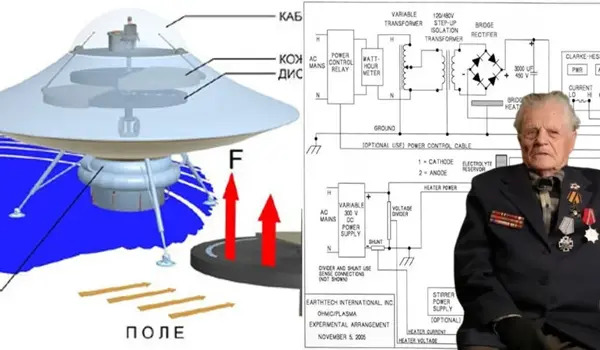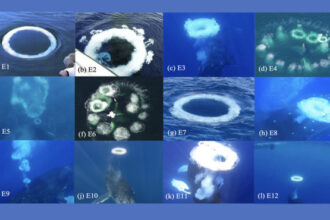Nikola Tesla, Alexander Weygers, Otis T. Carr are well-known names in the ufological field, famed for having designed and even developed exotic flying devices, “flying saucers.”
Well, today I bring you the case of a little-known man. I had to turn to Russian sources to find information about him—a Soviet physicist-inventor named Ivan Stepanovich Filimonenko.
Ivan Stepanovich Filimonenko was born in 1924 in the Irkutsk region of Russia. In 1941, at the age of 16, he joined the front lines. From 1941 to 1945, he served as a scout in the 191st Separate Motorized Rifle Reconnaissance Company, taking part in battles on the Southwestern, Northwestern, 2nd Ukrainian, and Trans-Baikal fronts during World War II. He received several honors, including the Order of the Red Banner, and medals such as “For the Victory over Germany,” “For the Victory over Japan,” “For the Liberation of Prague,” and “For the Capture of Budapest.”
From 1945 to 1951, he attended the Bauman Moscow State Technical University, graduating from the Faculty of Rocket Engineering. During his studies, Filimonenko proved to be a dedicated, disciplined, and socially active student. He was respected by fellow students, faculty leaders, and professors alike.
In 1957, Ivan Stepanovich Filimonenko proposed a new method for obtaining energy through the nuclear fusion of helium from deuterium. He was granted patent /38, titled “Thermionic Emission Processes and Systems,” which described “hot” nuclear fusion at a temperature of 1000˚C via electrolysis of heavy water.

Cold Nuclear Fusion Genius
The prerequisites for the emergence of this unique technology and facility date back to 1922. At that time, scientists S. Airion and J. Wendt published a paper in which low-energy element transmutation was mentioned for the first time. Four years later, F. Pannet and K. Peters published a scientific article on the transformation of hydrogen into helium. Their work also discussed the use of palladium as a catalyst for the reactions.
.jpeg)
In the 1950s in Russia, a hydrolysis plant was developed in one of the laboratories, capable of receiving energy from a thermonuclear reactor operating at 1150°C—a feat considered impossible at the time.
The fuel for the facility was “heavy” water, including deuterium. The “cold” nuclear fusion reactor decomposed this water through electrolysis, resulting in the formation of oxygen and deuterium. The latter then chemically reacted with the cathode (or more precisely, with the palladium from which the cathode was made) at the nuclear fusion level, producing helium.
.jpeg)
The facility, unlike all modern reactors, was completely safe from an environmental standpoint—there was no known radiation or waste. Filimonenko’s device operated by producing an incredible amount of energy in the form of high-pressure steam.
The installation was fully completed in 1957. Its inventor was the young physicist Ivan Stepanovich Filimonenko, who also discovered that during the device’s operation, previously unexplored radiation was emitted, and under its influence, the half-life of radioactive isotopes was reduced.
.jpeg)
In the 1960s, Filimonenko’s work was supported by Kurchatov, Korolev, and even Marshal Zhukov—other great and brilliant Russian minds. However, even they could not help Ivan Stepanovich when he tried to register his facility as a technological invention. The rejection seemed more than absurd: “thermonuclear reactions cannot occur at such a low temperature.” And this despite the device being tested and documented in operation!
However, by Special Secret Decree No. 715/296, dated July 23, 1960, the thermionic emission facility, as well as the principle of its operation, were strictly classified, and about eighty other laboratories and defense companies were involved in further studies of “cold” thermonuclear fusion.
.jpeg)
And then comes an absolutely incredible twist: in 1968, the department involved in improving the facility and the “cold” fusion process was shut down, and Filimonenko was forced to resign. Officially, this was due to violations of technical procedures during the facility’s operation and contamination of the surrounding area with radionuclides. More plausibly, it was because of the widespread development and installation of heavy metal reactors—modern nuclear power plants. Filimonenko became unnecessary; he and his facility stood in the way of influential people in nuclear development.
According to some reports, after his dismissal, Ivan Stepanovich Filimonenko was forcibly committed to a psychiatric hospital to finally stop his attempts to return to mainstream science.
Another Major Invention? Filimonenko’s Magnetoplane
The limited information you find about Ivan Stepanovich Filimonenko and his work on the Internet is generally linked to two discoveries and inventions by the Soviet physicist: a cold thermonuclear fusion facility and a magnetoplane. While some information may still be available about the first, there is very little regarding the second development.
.jpeg)
However, I came across an article titled “Flying Saucer. Manufactured in the USSR,” which contains design drawings and diagrams—although somewhat unclear due to poor digitization—presumably authored by Filimonenko himself. The comments attributed to Ivan Stepanovich are also interesting.
“He interacts with disks charged by the Earth’s magnetic field, hence the Lorentz force arises, which means it moves the aircraft.” (I.S. Filimonenko)
.jpeg)
From the article, we can conclude that Filimonenko’s magneto consisted of two disks, and the thrust was generated by the interaction of charged particles with a magnetic field. The design involved the rotation of the disks in opposite directions and some type of shielding circuit to protect against the external magnetic field. Two disks were necessary to balance the interaction system.
.jpeg)
The article also provided the following data: the discs were made of an insulator interspersed with metallic particles, each interacting with the field; when moving perpendicular to the direction of the field, the interaction force is maximum and disappears when moving parallel. The screen of the cover was designed to control this interaction so that only the maximum interaction force was used. It seemed to “shield” half of each disc from the external magnetic field.
According to Filimonenko’s calculations, the discs rotated at 1000 rpm. This was enough to produce a lifting force of “tens of tons.” Thus, traction control was achieved by accelerating or decelerating the rotation of the discs.
However, among researchers studying Ivan Filimonenko’s work, this article causes much controversy. Serious errors are evident: several calculations prove incorrect, and the proposed use of the material (insulator with metal parts) is considered unacceptable for such work… In other words, the article is, as they say now, “fake.”
Nevertheless, the flying disc, at least theoretically, was “built” by Filimonenko, and the goal was defined: to obtain a unidirectional driving force in a constant magnetic field (any, for example, Earth’s). This was achieved. Most who work with Ivan Stepanovich’s materials agree on this. It is only a matter of production technologies — if they had existed at the time Filimonenko was working, perhaps his “discs” would already be flying.
But there was no technology, nor testing. Another legend says that the intervention of Marshal Zhukov himself and the deaths of Kurchatov and Korolev deprived Filimonenko of all support for new experiments and the practical implementation of his ideas.
In the 1990s, Filimonenko still made his last attempt to interest the authorities in one of his inventions, cold nuclear fusion. But those were turbulent years for Russia, and the scientist’s results were disastrous. Physicist I. S. Filimonenko died in 2013 and, as he predicted, his developments served no one.
Below I leave a video in Russian (unfortunately I couldn’t find it with subtitles) about the physicist-inventor and his inventions:










